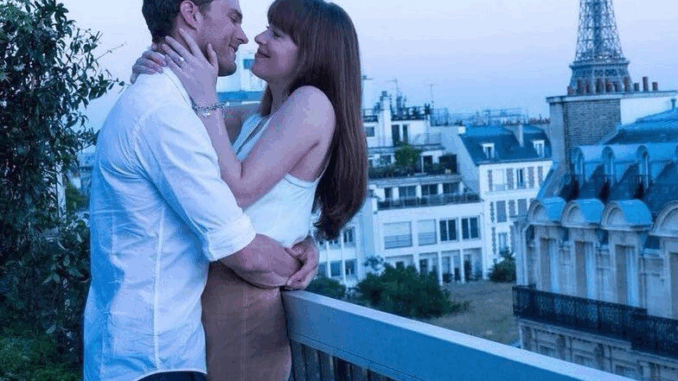
When Fifty Shades of Grey debuted in 2015, the world expected a provocative fantasy. What it got instead was a three-part saga that emotionally drained its cast, confused its audience, and left a legacy of regret disguised as success.
Behind the red rooms and steely gazes, there was another story unfolding — one of two actors slowly realizing they had stepped into something far darker than scripted tension. This is the uncomfortable truth behind Fifty Shades, the franchise that made Jamie Dornan and Dakota Johnson global names — and, according to whispers from the inside, almost broke them in the process.
“We Were Not OK” — Dakota’s Quiet Breakdown
In various interviews over the years, Dakota Johnson’s tone has shifted from cautious to quietly confrontational. Initially tight-lipped, she eventually let hints slip:
“I signed on for something that kept changing… and it wasn’t always good change.”
What many fans don’t know is that Dakota reportedly clashed with producers multiple times — not over pay or screen time, but over content escalation. As the sequels progressed, scenes became more extreme, emotionally manipulative, and psychologically draining, and Dakota was expected to perform them with a straight face.
Crew members later described her as “isolated between takes,” sometimes walking off set in frustration. One assistant director claimed:
“Dakota wasn’t acting in some of those scenes. She was really uncomfortable. But she did it because the contract was ironclad.”
She began referring to Fifty Shades as a “learning experience,” then later as something she was “still processing.” That shift in language? It wasn’t random.
Jamie Dornan’s Silent Rebellion
Jamie Dornan had a different coping strategy: withdrawal.
While promoting the final film, he gave nearly robotic answers to press questions — and dodged almost every inquiry about Christian Grey’s morality or his personal connection to the character.
“I’m not Christian Grey, I don’t want to be Christian Grey,” he said in an unusually blunt interview.
According to set insiders, Jamie clashed with directors and even refused to perform certain scenes unless they were rewritten. He allegedly told the cinematographer during Darker:
“This isn’t who he was supposed to be. This is just… twisted now.”
Jamie’s distance from the character became so apparent that body language experts picked it apart during press tours. His discomfort wasn’t just acting — it was rejection.
When The Fantasy Turned Hollow
The heart of the issue wasn’t nudity or bold themes — it was the erosion of the original emotional core. By the third film, even fans started to feel it: something was off.
The relationship between Christian and Ana stopped evolving.
The tension became repetitive.
The power dynamic lost meaning — and became hollow control.
One cut scene from Fifty Shades Freed reportedly showed Ana questioning Christian’s dominance in a raw, vulnerable moment — a moment that was later edited out entirely, allegedly for being “off-tone.”
Why? Insiders say studio execs believed that showing cracks in Christian’s persona would “kill the fantasy.” But to Jamie and Dakota, those cracks were the only thing that made the story human.
Controlled On Screen — Controlled Off Screen?
What fans didn’t realize at the time was just how much control extended off-screen. Jamie and Dakota were bound not only by their roles but by strict NDAs, intense schedules, and studio-imposed silence.
One anonymous PR insider described the press campaign as “the most micro-managed I’ve ever seen.” Even interviewers were warned in advance not to ask certain questions — particularly about how Jamie and Dakota truly felt.
Despite that, moments leaked through. Dakota once laughed nervously when asked if she enjoyed filming Freed, responding:
“I mean… we finished it. That’s a kind of enjoyment, right?”

The room laughed. But no one followed up.
“It Changed Us — And Not For The Better”
Years after the trilogy ended, both Jamie Dornan and Dakota Johnson have thrived in other roles. But whenever Fifty Shades is brought up, there’s always a pause. A tension.
In a 2021 interview, Dakota admitted:
“We did the best we could with what we had. But… I wouldn’t do it again.”
Jamie, meanwhile, compared his post-Fifty Shades career to “getting his name back.” A subtle phrase, but telling.
What was supposed to launch their careers instead became a weight to carry. For many, Fifty Shades is a guilty pleasure.
For Jamie and Dakota? It may always be a beautifully packaged regret.
The Franchise That Devoured Its Stars
In the end, Fifty Shades wasn’t just a trilogy. It was a machine — one that demanded more than just performance.
It demanded compliance. It demanded silence. It demanded the erosion of personal lines — something both Jamie and Dakota tried, and often failed, to protect.
Fans saw passion. But behind the scenes, there was discomfort, frustration, and, at times, quiet despair.
The fantasy came at a cost. And even now, the stars are still paying for it.
